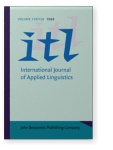Grammatical instruction and implicational features
Evidence from an experiment
John Lando | Australian Catholic University Melbourne - Australia
The present study examines the relationship between direct grammatical teaching of the past tense system of standard Italian and the use of some implicational features which, without being the object of direct instruction, are normally found within the same structure and context of the instructed ones. The subjects of the experiment were 60 tertiary learners of L2 Italian from a variety of Italian regional dialect background (age 18-25), receiving a period of intensive instruction on the use of the past tense system of standard Italian. The incidence of use of implicational features was measured on the basis of a written test prior to a three week period of intensive instructional treatment, followed by immediate and delayed written posttests. Similar monitoring was carried out with a control group of 40 comparable learners, who had not received direct instruction. The results of the study support the hypothesis that explicit and intensive form-focused instruction, when combined with continuous meaning-focused practice of instructed features, encourages an increased and more accurate use of other features that are closely related to the targeted ones.
References
DOUGHTY, C.
(
1988) :
The effect of instruction on the acquisition on relativization in ESL. Unpublished Ph.D. dissertation, University of Pennsylvania.

DOUGHTY, C.
(
1991) : ‘
Second language instruction does make a difference: evidence from an empirical study of SL relativisation.’
Studies in second language acquisition 13 (2): 431–69.


ECKMAN, F.R.
(
1992) :
Second-language acquisition or secondary languages? : a linguistic perspective. Paper presented at the Twelfth Second Language Research Forum, East Lansing, MI.

ECKMAN, F.R., BELL, L. and NELSON, D.
(
1988) : ‘
On the generalisation of relative clause instruction in the acquisition of English as a second language’.
Applied linguistics 9 (1): 1–20.


GASS, S.M.
(
1981) :
From theory to practice. Paper presented at the Fifteenth Annual TESOL Convention. Detroit, MI.

GASS, S.M
(
1982) : ‘
From theory to practice’. In
Hines, M. and
Rutherford, W., eds,
On TESOL ‘81 : Selected Papers from the Fifteenth Annual Conference of Teachers of English to Speakers of Other Languages, pp. 129–39. Washington, D.C., TESOL.

HAMILTON, R.L.
(
1994) : ‘
Is implicational generalization unidirectional and maximal? Evidence from relativization instruction in a second language.’
Language learning, 44 (1), pp. 123–57.


HENRY, A.
(
1986) :
Linguistic theory and second language teaching. Paper given at CILT Workshop on acquiring language and learning languages, Cumberland Lodge, Windsor Great Park.

HUNTLEY, H.S.
(
1992) : ‘
Feedback strategies in intermediate and advanced second language composition.’ Mimeo. Educational Resources Information Centre.

KEENAN, E. and COMRIE, B.
(
1977) : ‘
Noun phrase accessibility and universal grammar.’
Linguistic inquiry, 81:63–99.

LANDO, J.
(
1996a) :
The effect of instruction on the use of the past tense system in the writing of learners of Italian. Unpublished doctoral dissertation. La Trobe University.

LANDO, J.
(
1996b) : “
These students were taught grammar : was it worthwhile?”. In and
Arbonés and Solà and
et al., eds,
Who’s afraid of teaching grammar?, pp. 27–36. Queensland, The University of Queensland.

PIENEMANN, M. and JOHNSTON, M.
(
1987) : ‘
Factors influencing the development of language proficiency’. In and
Nunan, D., ed,
Applying second language acquisition research, pp. 45–14. Adelaide, National curriculum resource centre, Adult Migrant Education Program.

RUTHERFORD, W.
(
1989) : ‘
Preemption and the learning of L2 grammars.’
Studies in second language acquisition, 111: 441–57.


VAN PATTEN, B. and CADIERNO, T.
(
1993) : ‘
Explicit instruction and input processing’.
Studies in second language acquisition 15(2): 225–41.


WOLFE-QUINTERO, K.
(
1992) : ‘
Learnability and the acquisition of extraction in relative clauses and WH-questions.’
Studies in second language acquisition, 141: 39–70.


ZOBL, H.
(
1983) : ‘
Markedness and the projection problem’.
Language learning 331:293–313.


ZOBL, H.
(
1985) : ‘
Grammars in search of input and intake’. In and
Gass, S. and
Madden, C., eds,
Input in second language acquisition, pp. 329–44. Rowley, Mass., Newbury House.

Cited by
Cited by 1 other publications
Chan, Alice Y. W.
2006.
An Algorithmic Approach to Error Correction: An Empirical Study.
Foreign Language Annals 39:1
► pp. 131 ff.

This list is based on CrossRef data as of 1 april 2024. Please note that it may not be complete. Sources presented here have been supplied by the respective publishers.
Any errors therein should be reported to them.
